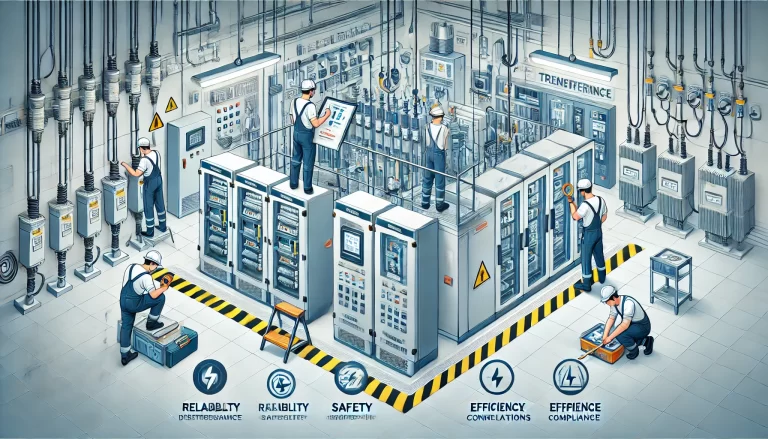A distribution room plays a vital role in the power system by ensuring the safe and reliable transfer of electricity from power plants or substations to end users. Acting as a critical node in power distribution, it safeguards the stability and continuity of electricity supply for residential, commercial, and industrial purposes. Regular maintenance of the distribution room is essential to ensure the optimal performance, safety, and longevity of its equipment. Below, we delve into the key reasons why regular maintenance is indispensable for distribution rooms:
1. Ensuring Reliability of Power Supply
Regular maintenance allows for the timely identification and resolution of potential equipment issues. This proactive approach significantly reduces the likelihood of equipment failures or unplanned outages. A reliable power supply minimizes disruptions to daily operations and production processes, thereby preventing significant economic losses or inconveniences.
Example: A manufacturing plant that implemented a regular maintenance program observed a 30% reduction in downtime due to fewer power interruptions.
2. Guaranteeing the Safe and Stable Operation of the Power System
Over time, factors like electrical wear, overloading, and environmental conditions (e.g., moisture, dust, or corrosion) can impact the performance of distribution equipment. Regular inspections and corrective actions help address these risks, preventing sudden breakdowns and ensuring the stable operation of the power system.
Example: An inspection of aging switchgear identified insulation deterioration early, allowing for timely replacement before a major fault occurred.

3. Extending Equipment Lifespan
Scheduled maintenance activities, such as cleaning, lubrication, and component replacement, reduce wear and tear on equipment. Keeping systems in optimal condition extends their service life and reduces the frequency and cost of replacements.
Technical Note: For instance, regular thermographic scanning can detect overheating components, which, if left unchecked, could lead to premature failure.
4. Enhancing Electrical Safety
Regular maintenance uncovers potential hazards like loose electrical connections, insulation aging, and grounding issues. By addressing these problems promptly, the risk of electrical accidents, such as short circuits, fires, or electrocution, is significantly minimized, ensuring the safety of personnel and property.
Case Study: A commercial building avoided a potential fire hazard when routine maintenance revealed overheating busbars caused by loose connections.
5. Improving Equipment Performance and Efficiency
Maintenance activities, including calibration, cleaning, and system tuning, enhance the operational efficiency of distribution room equipment. By optimizing energy transmission and minimizing losses, these measures contribute to better overall system performance and lower energy consumption.
Insight: Studies indicate that well-maintained transformers can achieve efficiency improvements of up to 5%, leading to notable energy savings.
6. Ensuring Compliance with Regulations and Standards
Many regions have stringent regulations governing the maintenance and operation of electrical equipment. Regular maintenance ensures that distribution rooms meet these legal and technical requirements, avoiding penalties and ensuring safe, compliant operations.
Example: Compliance with ISO 45001 (Occupational Health and Safety Management) often includes specific provisions for electrical safety that are addressed through periodic maintenance.

7. Reducing Repair Costs
Proactive maintenance detects minor issues before they escalate into significant failures. Addressing problems early avoids costly emergency repairs or replacements, saving both time and resources.
Financial Highlight: A logistics company cut repair costs by 25% after implementing a preventive maintenance plan for its distribution systems.
8. Preventing Major Accidents
Replacing aging components and addressing potential faults through regular maintenance reduces the risk of catastrophic failures. This proactive approach minimizes downtime, protects investments, and ensures smooth business operations.
Case Study: Routine inspections identified structural weaknesses in an older distribution panel, preventing a major outage during peak demand.
9. Enhancing Energy Efficiency and Supporting Sustainability
Through regular maintenance, equipment is calibrated and optimized for energy efficiency, reducing power losses and supporting sustainability goals. This contributes to a greener, more environmentally friendly energy ecosystem.
Environmental Impact: Improved energy efficiency in distribution rooms can reduce annual carbon emissions by a measurable percentage, aligning with corporate sustainability targets.

Conclusion
The regular maintenance of distribution rooms is not just a recommended practice; it is a necessity for ensuring safety, reliability, and efficiency in power systems. By proactively addressing potential issues, organizations can prevent costly breakdowns, extend the lifespan of equipment, and comply with regulatory requirements. A well-maintained distribution room ultimately provides a foundation for uninterrupted power supply and efficient energy utilization, delivering long-term economic and operational benefits.
